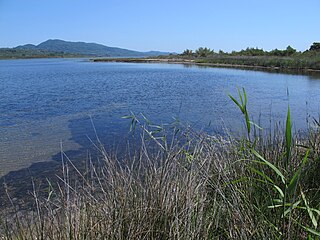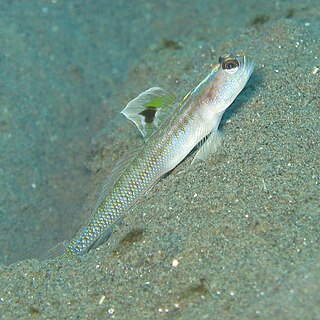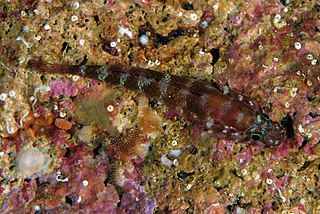Victor Gruschka Springer was an American biologist who was a Senior Scientist emeritus, Division of Fishes at the Smithsonian Institution's National Museum of Natural History in Washington, D.C. He was a specialist in the anatomy, classification, and distribution of fishes, with a special interest in tropical marine shorefishes. He published numerous scientific studies on these subjects; also, a popular book called "Sharks in Question, the Smithsonian Answer Book" 1989.
Glossogobius hoesei, Hoese's goby, is a species of goby endemic to the Ayamaru Lakes in West Papua, Indonesia where it can be found on muddy or gravel substrates as well as in small tributary streams. This species can reach a length of 7 centimetres (2.8 in) SL. The specific name honours the ichthyologist Douglass Fielding Hoese of the Australian Museum in Sydney who has made an important contribution to the study of fishes in the order Gobiiformes.

the Corfu dwarf goby is a species of freshwater goby endemic to the island of Corfu in western Greece. This species can reach a length of 2.2 centimetres (0.87 in) SL. This species was only recorded from a single spring and was considered to have been last recorded in 1983 but surveys in the 1990s failed to find any, it was incorrectly thought that the spring which was the type locality had been affected by water abstraction which may have caused an increase in salinity, but the species had not been recorded at the affected spring. In 2014, nine specimens of Corfu dwarf goby were collected from Korission Lagoon in southern Corfu. The specific name honours Manfred Görner, who supported the author's ichthyological research.

Vanderhorstia is a genus of gobies native to the Indian and Pacific oceans. The name of this genus honours the Dutch biologist Cornelius van der Horst (1889-1951) of the University of the Witwatersrand, Johannesburg, who was well known for his interest in marine biology.

Tomiyamichthys is a genus of gobies found from the Red Sea through the Indian Ocean to the western Pacific Ocean.
Gobius senegambiensis is a species of marine fish from the family Gobiidae, the true gobies. It is native to the Atlantic Ocean from Morocco to Angola as well as the islands in the Gulf of Guinea. It is found in inshore waters on sandy bottoms. This species can reach a length of 7.3 centimetres (2.9 in) SL.
Knipowitschia iljini is a species of goby Endemic to the Caspian Sea, where it inhabits the deep waters in the central part. This species can reach a length of 4.7 centimetres (1.9 in) TL. The specific name honours the taxonomist of Gobiiformes Boris Sergeevich Iljin (1889-1958), who researched the gobies of the Black and Caspian seas.

Didogobius is a genus of small marine fish in the family Gobiidae, the true gobies. They are native to the eastern Atlantic Ocean and the Mediterranean Sea. The name of the genus is a compound noun made up of Dido, the mythical founder and first queen of Carthage, and the Latin gobius meaning "goby".

Steinitz's goby is a species of goby. It is native to the Mediterranean Sea near Marseilles. It has been recently recorded in the Adriatic Sea in Croatia, Tyrrhenian Sea in Italy, and in the Black Sea in Ukraine. This species can be found in underwater grottoes in inshore waters at depths of 2 to 15 metres. Steinitz's goby can reach a length of 3.8 centimetres (1.5 in) SL. Its name honours the marine biologist and herpetologist Heinz Steinitz (1909–1971) of the Hebrew University, Jerusalem.
Gerald Robert "Gerry" Allen is an American-born Australian ichthyologist. His career began in 1963, when he spent a semester at the University of Hawaii, where he also received a PhD in marine zoology in 1971. In 1972, Allen wrote his doctoral thesis on the systematics and biology of the anemone fish.

Apocryptodon is a genus of gobies in the family Oxudercidae, native to the Indian Ocean and the western Pacific Ocean.
Mahidolia is a small genus of gobies native to the Indian Ocean and the Western Pacific Ocean. Both species are commensal with species of alpheid shrimps.

Oxuderces is a genus of fish in the family Gobiidae native to fresh and brackish waters of coasts of the Indian and Pacific Ocean.

Vanderhorstia mertensi, Mertens' shrimp goby or the slender shrimp goby, is a ray-finned fish species native to the Red Sea, Japan, Papua-New Guinea and the Great Barrier Reef. Male individuals can reach a length of 11 cm in total. In 2008 a first specimen was collected in the Mediterranean Sea, in the Gulf of Fethiye, southern Turkey, where it was found on sandy bottoms in the vicinity of beds of sea grass. It is now common in Israel, Turkey and Greece. According to the Mediterranean Science Commission this species most likely entered the Mediterranean via the Suez Canal from the Red Sea.
The specific name honours the German herpetologist Robert Mertens (1894-1975), the former director of the Naturmuseum Senckenberg in Frankfurt, from whom the author, Klausewitz, learnt about the biological and ecological view of modern systematics and taxonomy.
Alwyne (Wyn) Wheeler was a British ichthyologist who was a curator at the Natural History Museum in London. He was educated at St Egbert's College, Chingford, and Chingford County High School to Higher School Certificate level, and was unusual in that his subsequent scientific career was achieved despite his never having obtained a university degree.

Nematogobius maindroni is a species of ray-finned fish from the family Gobiidae, a true goby. It is native to the Eastern Atlantic from Senegal to Angola, it has also been reported from Namibia and from the islands in the Gulf of Guinea. It is common in brackish estuaries, but may migrate up rivera into freshwater. The specific name honours the French entomologist Maurice Maindron (1857-1911), the collector of the type specimen from Senegal.
Helen K. Larson is an ichthyologist who specialises in the fishes of the Indo-Pacific.
Platygobiopsis tansei is a species of goby found around Japan. This species reaches a length of 4.7 cm (1.9 in).
Stiphodon larson is a species of goby found in Papua New Guinea. This species can reach a length of 3.1 centimetres (1.2 in) SL.

Oxuderces dentatus, is a species of goby found in the Indo-West Pacific from India to Vietnam, Macau, China, Malaysia and Indonesia.









